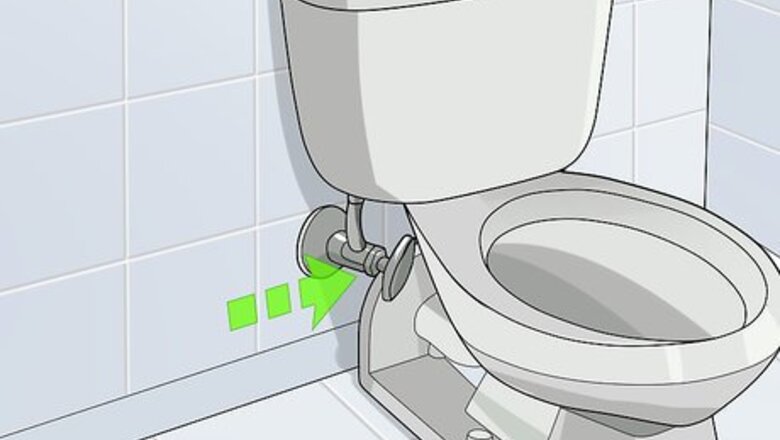
views
Closing the Toilet’s Shutoff Valve
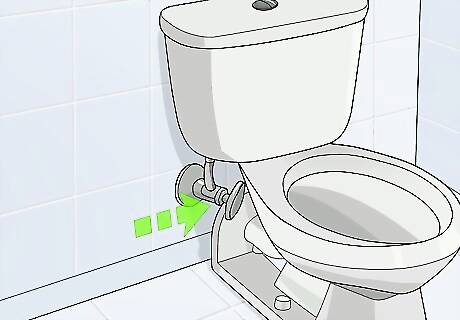
Locate the shutoff valve attached to the pipe behind your toilet. The shutoff valve is a football-shaped valve connected to a pipe or hose attached to the bottom of the tank behind your toilet. The other end of this pipe should go into the wall. Some older toilets don’t have shutoff valves behind them. If this is the case for you, you’ll have to use the wooden board method or simply cut off the main water supply for your entire home to turn off the toilet’s water supply.
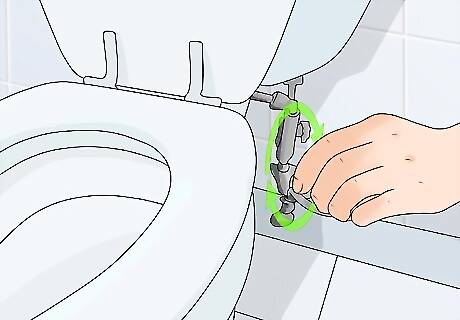
Turn the valve clockwise until it can’t turn anymore. Turning the valve clockwise as far as it can go will turn off the water supply to the toilet. The valve should not be difficult to turn, so don’t try to force it if you can’t easily turn it. If the water valve looks rusty or is difficult to turn, try applying some WD-40 to it. If you’re still unable to turn it after this, you probably will need to replace it. EXPERT TIP James Schuelke James Schuelke Professional Plumber James Schuelke, along with his twin brother David, is the co-owner of the Twin Home Experts, a licensed plumbing, leak detection, and mold inspection company based in Los Angeles, California. James has over 32 years of home service and business plumbing experience and has expanded the Twin Home Experts to Phoenix, Arizona and the Pacific Northwest. James Schuelke James Schuelke Professional Plumber Make sure to shut the valve securely. When the valve is off, give it an extra quarter-turn to the right to make sure the water is completely off.
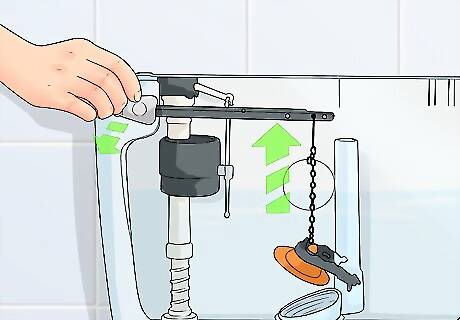
Flush your toilet to make sure the water is turned off, if you can. If the water supply is turned off, the water in the back tank will empty out into the toilet bowl and will not be refilled afterwards. If your toilet is clogged, you can also test if the water has been turned off by lifting the float lever in the tank. This is the lever attached to the hollow, sealed float on top of the water in the tank. If the water is still on, more water will be added to the tank when you push this lever down. Note that if the water is still turned on, you’ll need to quickly push the float lever back up to prevent the tank from overflowing.

Turn the valve counterclockwise when you’re done to turn the water on. Once it’s time to turn the water supply to the toilet back on, all you have to do is simply turn the water valve counterclockwise as far as you can. Give the toilet a flush to test it and make sure the water is turned back on. EXPERT TIP David Balkan David Balkan Professional Plumber & CEO of Balkan Sewer & Water Main David Balkan is a Professional Plumber, CEO of Balkan Sewer and Water Main Service, and President of Balkan Sewer and Drain Cleaning. As a hands-on owner of these companies for over 40 years, David is knowledgeable about water service lines, sewers, and drain line issues. David is a Committee Chairman of the Master Plumbers Council and has sat on the Executive Committee of the Sub Surface Plumbers Association of New York for over 30 years. His knowledge and solution-oriented approach contributed to Balkan Sewer and Water Main Service being the largest and most trusted service in New York City and the recipient of the 2017 Angie’s List Super Service Award. David Balkan David Balkan Professional Plumber & CEO of Balkan Sewer & Water Main Shut off fixtures before turning off the main valve. If you need to cut off the main water supply to your property, always close the valve closest to the indoor plumbing, not the main valve by the street cutoff. If you close the main valve and it breaks or has an issue, you cannot replace or repair it.
Turning Off the Main Shutoff Valve

Look for the valve in the basement if you live in a colder climate. In colder areas where freezing temperatures are more common, the water meter and main shutoff valve are typically located indoors. Look in the basement near the first foundation wall or in the crawl space underneath your home. If you can’t find your water meter and valve in these typical locations, your best bet is to contact a professional plumber to have them locate your meter for you.
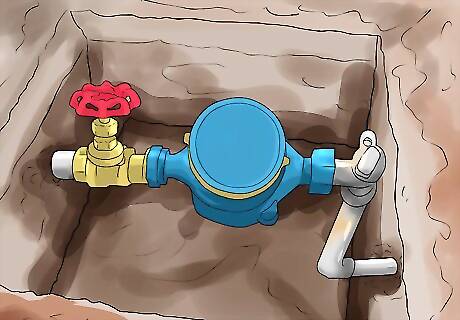
Check outside to find the valve if you live in a warmer climate. The water meter and main shutoff valve will probably be located in an iron box underground along the side of your home. Don’t worry about it being underground, though; you’ll be able to spot the lid covering the meter above ground. The main shutoff valve will be 1 or 2 “wheel” handles or lever handles jutting above or next to a metal pipe. They will probably be on either side of a water meter. If you have an external water heater on a side or in back of your home, there’s a good chance the water meter will be somewhere near this.
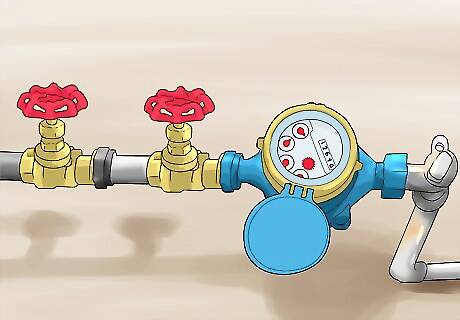
Note that the shutoff valve usually looks like 1 or 2 “wheel” handles. These are circular handles with finger-sized indentations along the circumference that allow you to get a better grip on them. There will most likely be a water meter located in between these 2 handles along a water pipe running into your home. Some shutoff valves feature lever handles instead of wheel handles.
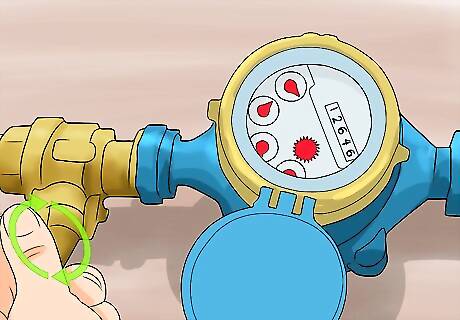
Turn the valve clockwise to shut off your main water supply. This will stop all the water flowing into your home, including the water supply to the toilet. If there are 2 valves on either side of the water meter, turn the one that is closest to your home. If there’s only 1 wheel handle or lever handle, that’s the one you’ll want to operate to turn off the main water supply. Once you’ve finished with your work, simply turn this valve counterclockwise again to turn the water back on.
Propping up the Float Lever

Take the lid off the tank and find the float near the top of the water. When this hollow container floats to a certain height, the valve stops letting water into the tank. When you flush the toilet, the float falls with the water level and reopens the water valve. To prevent water from refilling the tank, you’ll need to secure the float to prevent the valve from opening after a flush.
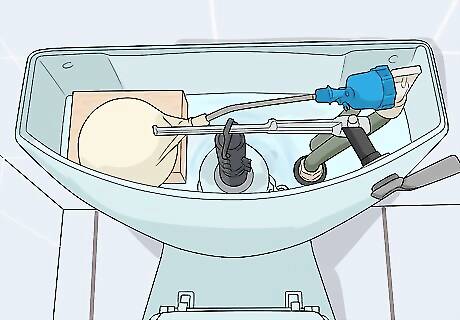
Slip a narrow length of wood under the float lever to hold it up. Position the piece of wood vertically so that the bottom of it rests on the bottom of the tank. This way, the top of the wood will hold the float lever up and prevent it from causing the tank to refill after a flush. For best results, use a piece of wood that is about 1 inch (2.5 cm) shorter than the height of the tank itself. If the sides of the tank are too high to do this, then straddle the board above the float lever and wrap a length of stiff wire around both the float arm and the board to hold the float up.Tip: Note that anything tall and sturdy enough to hold up the float lever can be used in this method, as long as it can hold up to being placed underwater.

Flush the toilet to drain the water out of the tank, if you can. The tank will empty, while the wood or wire strapping holds the lift arm up, preventing the valve from refilling the tank. If your toilet is clogged and you can’t flush it, you can also use a bucket or tall cup to lift the water out of the tank until it’s empty.
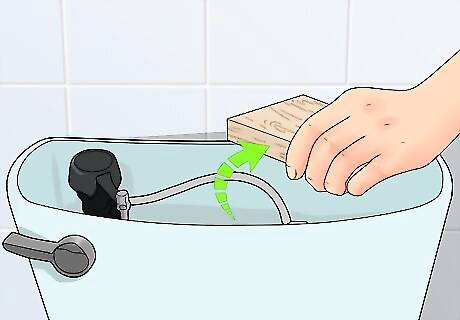
Remove the board when you’re done to allow the tank to refill. After you’re finished with your repair work, simply remove the board and or strapping to allow the float to refill the tank. Place the lid back on the tank and you’re good to go!

















Comments
0 comment